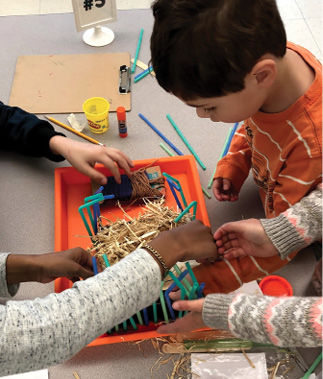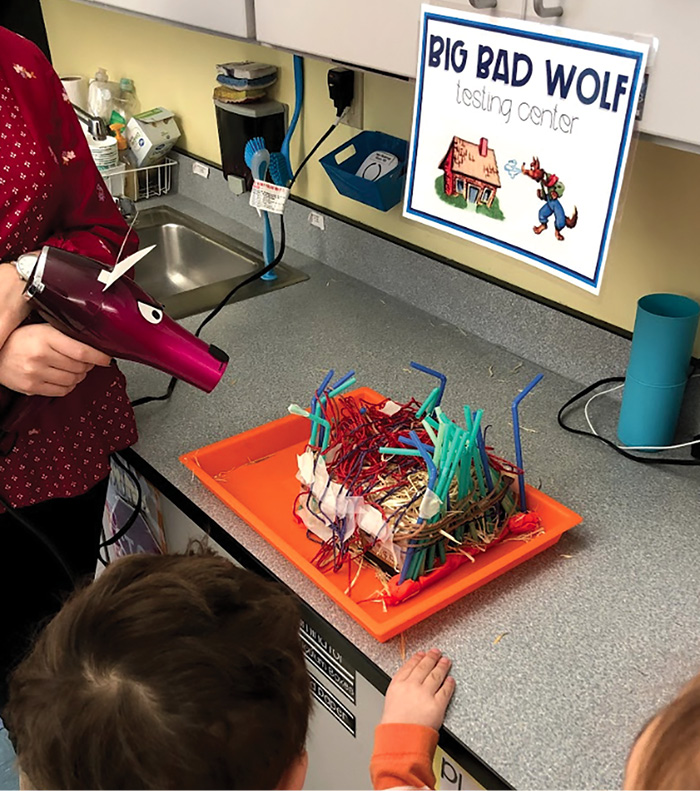Cross-curricular Connections
Cross-grade Collaboration
When students of different ages work together, social and emotional learning is enhanced
Science and Children—May/June 2022 (Volume 59, Issue 5)
By Debbie Ericksen and Rachel Glassman
When our students enter our classrooms each day, we aren’t just teaching them content. We are also teaching them social and self-awareness, empathy, responsibility, and how to establish and maintain relationships (CASEL). Our elementary school has a diverse student population of approximately 550 children. The fourth-grade students referred to in this article were in a general education classroom; some received tiered services. All of the preK students received special education services. The relationships established between our students provided a rich environment for them to grow and learn in ways we never anticipated. We have taken what may be a familiar activity (inspired by the Mid-Columbia STEM Education Collaboratory “Three Little Pigs Design Challenge”) and made significant revisions to meet the academic, communication, and Social and Emotional Learning (SEL) needs of our students. The steps within this investigation as well as the overall cross-grade collaborative relationships that were established throughout the year address the need for cultural relevance in our instructional practices. Students learned that their gender, age, economic status, and cultural differences did not create barriers for working together and for being successful in achieving goals.
Prior to the investigation in this article, students engaged in several ELA and arts activities to build relationships with each other. During those activities, we paired students using their personality traits based on who we thought would work best together, and the communication needs of the preK students (based on IEPs). Minor adjustments needed to be made. However, we were then able to keep the same groupings together for the STEM investigation. This was extremely helpful because the students were already comfortable with each other and readily communicated to achieve their goals. There were more fourth graders than preK students, so we generally grouped approximately two to three fourth-grade students with every one to two preK students. The fourth graders used role-playing techniques to learn strategies for supporting communication and socialization with “the littles.” We planned several scenarios the fourth graders might encounter (e.g., a preK student who won’t talk or won’t remain on task, a fourth grader wanting to do a task independent of a preK student, a preK student needing encouragement to use their words to communicate) based on our observations during earlier tasks. Our biggest challenge was identifying common standards between preK and fourth grade. The NJSLS Early Childhood guidelines for STEAM recommend that students are exposed to open-ended investigations to develop their inquiry skills (https://www.state.nj.us/education/ece/guide/standards.pdf). The Three Little Pigs investigation connected fourth-grade engineering and earth science core ideas about natural hazards to preK study of weather and structures. The story provided an analogy for hurricane force winds. However, if your area does not experience hurricanes, you could revise the scenario to include strong thunder and lightning storms and/or blizzards. PreK read the classic story. The fourth grade read The True Story of the Three Little Pigs and the Big Bad Wolf (Scieszka 1989). Afterward, the fourth graders decided whether they thought the pigs or the wolf was telling the truth. We also discussed how perspective can change based on point of view.

Building and Testing
When our classes reunited, we reread the classic version of the story (to support preK recall of details) with pictures displayed of the three different types of houses in the story. Next, small groups of preK and fourth-grade students selected a house in the story to illustrate. As students shared their pictures, we discussed and recorded the advantages and problems with each house. Afterward, we explained that we had a challenge for them. They would need to build a house that would protect their very own little pig and withstand the winds from the big bad wolf!
Students had spent a lot of time together, so we had a good understanding of how long it took them to complete tasks together. We budgeted for two hours with a snack break in between. We also provided a break area for preK students who needed it. Each group identified a problem with the construction of a house that they wanted to address. Then, the design process began, with each group provided with a list of available supplies as well as the criteria and constraints of the project. (Fourth graders had already learned about criteria and constraints. However, if your students are not familiar with these terms, you will need to provide a mini-lesson to support their understanding.) Supplies were on display, but we did not give the groups their bins until their design sketch was finished. The fourth graders applied what they knew about wind energy transfer to design a house that would be hurricane-resistant. The preK students helped draw the design and identify the materials that would be used. For the latter activity, pictures of each material were cut out and glued onto the planning paper. Once the plan was checked by a teacher, each group retrieved a bin of supplies. The total cost of the class supplies came to approximately sixty dollars. However, the expense can be reduced by reducing the supply list (recommended later in this article) and/or requesting PTO grant money (which we have done for other activities). Students built their houses on plastic trays so that it was easier to move to the testing center later on. As children worked, the teachers and assistants circulated throughout the classroom to monitor students’ interactions and progress. We assisted as needed and provided time checks every 30 minutes. Teacher assistants provided additional support for students with significant needs. As we stood back and watched, the age difference between our students seemed to melt away and they were just young engineers trying to solve a problem together. When their structures were complete, it was time to test them.
Each group proudly brought their houses to the testing center. Hair dryers were the wind energy source and were disguised as wolves with stick-on ears and eyes. We controlled the hair dryer for safety and to make sure the wind direction and distance was consistent. Students closely observed the movement of the materials and identified any fail points. We used low and high settings for wind speed and increased the length of time the wind was blowing. Some materials blew off, and at least one of the structures collapsed. When that happened, students went back, adjusted their design and retested. For the structures that passed the initial test, groups enhanced their design. Often, the additional weight of the new materials caused it to collapse. Once all groups had tested and redesigned at least once, we provided 20 minutes for cleanup.

Reflecting
Once back in their own classroom, the fourth graders completed a written reflection about their work. The preschoolers reflected as well, by looking at the pictures (which teachers had taken) of their houses and discussing what worked and what did not work. Students noted their own (as well as others’) growth in stamina, focus, and communication. They also addressed flaws in their designs and how they would fix them.
We noticed several important SEL components throughout the collaborative process. First, the preK students were motivated by the older students. The younger students naturally looked up to the older students and often wanted to imitate behaviors. Over time, the age difference didn’t seem as noticeable, and instead the students saw each other as friends and colleagues. Second, we observed preK students, struggling with communication, become more proficient and comfortable with verbal interactions. This progression occurred as they became more familiar with their older friends. We observed the fourth-grade students learning to be better active listeners and more receptive to others’ ideas. Additionally, as students’ self-confidence improved, they were better equipped to advocate for themselves and persevere through problem solving.
This investigation provided multiple assessment points for preschool in terms of communication, social interactions, and understanding the details of a story. PreK students are assessed differently than fourth-grade students. Checklists according to IEPs and required learning outcomes are used instead of the rubrics often used for formal assessment of upper elementary students. There are several formative assessment points for this activity. During the reading of the story, the younger students were able to share the details they recalled from the story. The older students discussed point of view and its impact on the story. They also engaged in a spirited debate about who they thought was telling the truth. The house illustrations and class discussion provided us with insight into how students were applying critical thinking skills to evaluate the benefits and problems of each structure. During the engineering task, we were able to informally assess students’ communication skills and application of science understandings (fourth grade) and the engineering process. Since stability and change was a crosscutting concept used in this investigation, we were excited to see that the three- and four-year-olds were able to appropriately use the words stable or unstable when discussing their structure. Fourth graders referred to energy transfer through wind (learned in prior lessons) to help explain the threats to the stability of their structures. We used those observations to redirect and support students as needed. Last, the fourth-grade reflection provided us with details about their science understandings (explored in earlier lessons about the wind’s effect on the surface of the Earth) as well as about working with the younger students. While we did not identify any student misconceptions as a result of the engineering investigation, the fourth graders did participate in an informal class discussion that addressed variables affecting the success and/or failure of the structures (i.e., weight of the materials, height of the structure, direction, and strength of the wind).
In the future, we suggest using fewer materials (perhaps removing the skewers, yarn, and ziti pasta) We would also change the design criteria to require a taller structure. All groups built a one-level structure (probably because it’s what they saw in the story), which was naturally more stable than a taller structure. Other suggested modifications include: smaller groups or partner work, keeping the supply list very basic, shortening the overall time of the activity, and providing frequent breaks.
Cross-grade collaboration enhanced learning for our students with diverse needs. Fourth-grade students helped preK students develop language and social skills through discussions and asking questions. Older students who struggle with behavior issues or a lack of self-confidence, embraced the leadership opportunities that came with collaboration. Furthermore, preK students have access to learning about science and engineering before they are formally introduced to it in kindergarten. We are excited to follow their growth and to observe the impact that this early learning has on their future understanding and application of science and engineering.
Supplemental Resources
Download unit materials at https://bit.ly/38gCXhf
Online Resources
CASEL: Research-Practice Partnerships
https://casel.org/research
Collaborative Learning
https://teaching.cornell.edu/teaching-resources/engaging-students/collaborative-learning
Cornell University Center for Teaching Innovation
https://teaching.cornell.edu/teaching-resources/engaging-students/collaborative-learning
RAND Organization Research
https://www.rand.org/education-and-labor/centers/sel.html
Debbie Ericksen (Debe506@att.net), PAEMST 2016 (Science), is a retired teacher from Adamsville Primary School in Bridgewater, New Jersey. Rachel Glassman is a special education teacher at Adamsville Primary School.
Inclusion Interdisciplinary Literacy Elementary


